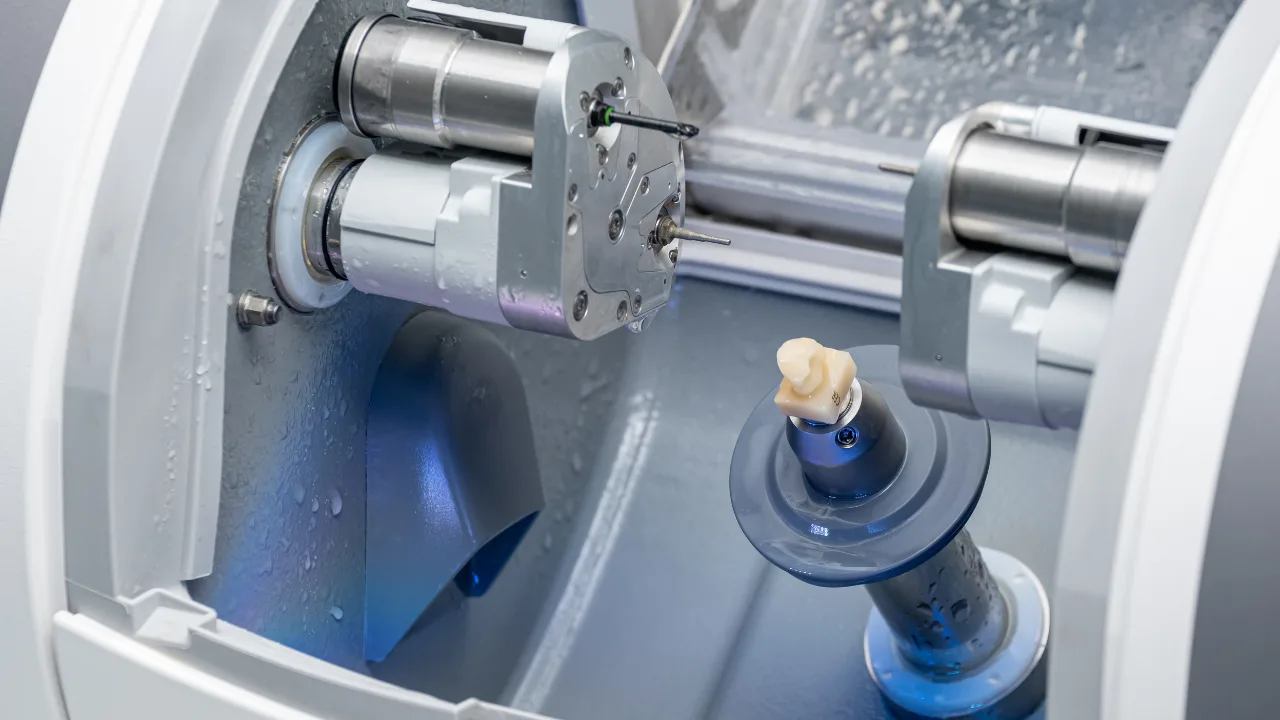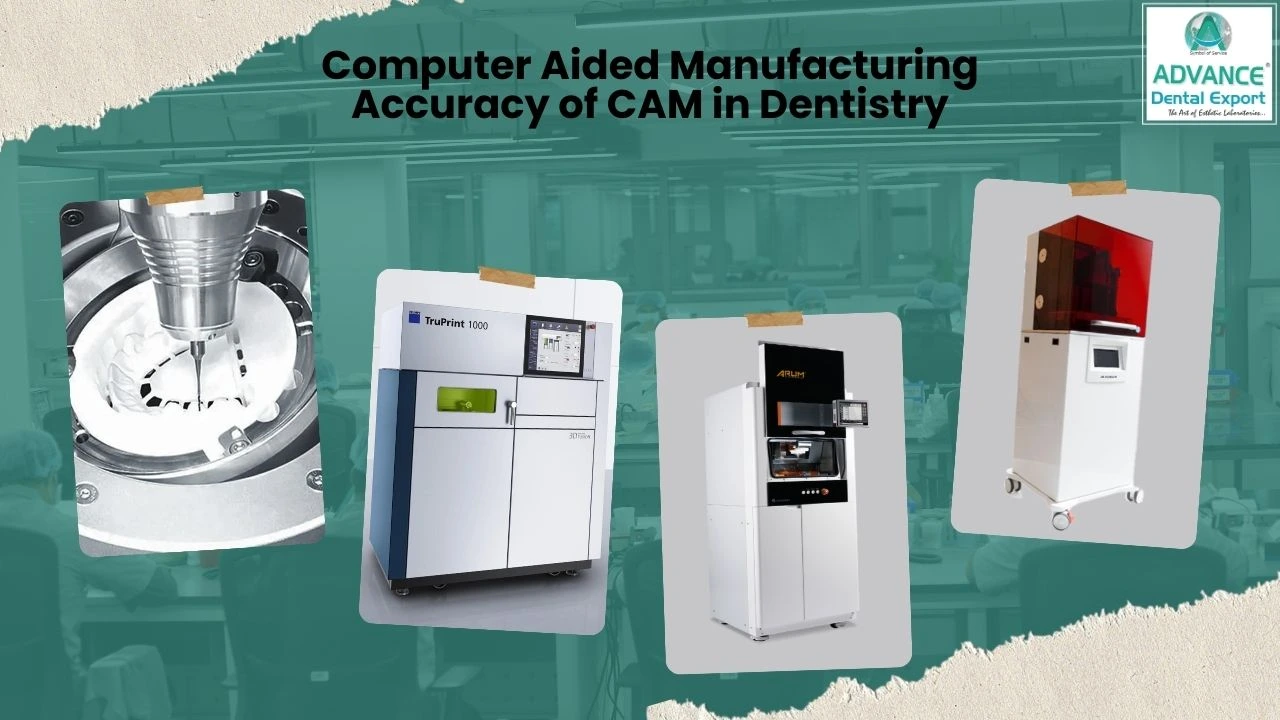
Revolutionizing Dental Labs: Transformative Impact of CAD/CAM Technology
Discover the importance of CAD/CAM technology in dental labs. Explore how it is improving accuracy, streamlining workflows, and enhancing patient satisfaction.

Posted Sept. 24, 2025 by Haresh Savani
Have you ever wondered how a dental crown or veneer is made so perfectly? Now digital dentistry has come a long way. For years, plaster molds and handmade engravings were used to create crowns and bridges. These methods were time-consuming and prone to error. As dentistry advances, advanced technologies like computer-aided manufacturing (CAM) have changed the entire process. CAD/CAM technology uses digital scanning and computer-controlled machinery to create restorations with precision.
But, how accurate is CAM technology? What is its post-processing procedure? How can CAM technology and manufacturing be made better and more reliable? Let’s explore all these in detail.
CAM (Computer-Aided Manufacturing) is the process of manufacturing precisely designed objects using computer-controlled technology. In simple terms, a machine manufactures a physical object from a digital design.
In dentistry, the production of dental prostheses is mainly divided into two parts:
In this part, a digital impression of the patient's teeth is taken. This scan is more comfortable than traditional silicone mold. Using this data, a 3D model is created on the computer. The technician virtually designs a crown, bridge, or veneer on this model.
Once the CAD design is complete, the data is sent directly to a milling machine or 3D printer for fabrication. This machine carves a dental restoration of a specific size from a block of solid material (e.g., Zirconia, Emax). The entire process is extremely fast and accurate with minimal human error.
CAM technology is used in dentistry to create a variety of restorations and appliances. This technology has made many procedures easier, faster, and more accurate. Here are some of its main uses:
Dental crowns: CAM is most commonly used to fabricate crowns. Traditionally, it took several visits to create a crown, but with CAM technology, crowns can often be created in a single visit.
Dental bridges: CAM is also used to create bridges to replace missing teeth. This technology ensures the bridge is so precise that it fits perfectly with the adjacent teeth.
Dental veneers: Thin shells, called veneers, used to improve the appearance of teeth, can also be created with CAM technology. This allows the color and shape of the veneers to match the natural teeth.
Dental inlays and onlays: These types of restorations, which are used to restore small parts of the tooth, can also be made with extreme precision using CAM.
Digital dentures and surgical guides: CAM technology is also used to create digital dentures and surgical guides. During implant surgery, the surgical guides help the doctor determine the correct location and angle for placing the implant, making the entire procedure safer and more accurate.
Thus, CAM technology is revolutionizing almost every aspect of the dental field, with precision, speed, and patient satisfaction being prioritized.
One of the most important questions for both dentists and patients is: “How accurate is computer-aided manufacturing?” Compared to traditional methods, where the human eye and hand have limitations, the CAM process is based on digital data, which provides extreme precision.
Micron-level precision: Most modern CAM systems provide a precision of 10 to 20 microns. One micron is much thinner than a strand of hair. Due to this precision, the marginal gap of the restoration (the space between the tooth and the crown) is extremely small, which reduces the risk of microleakage and bacterial infection.
Precise fit and less adjustment: A direct result of this precision is that fewer adjustments are required to fit the crown in the patient’s mouth, which saves the doctor time and reduces discomfort for the patient.
This technology makes the crown so precise that it fits perfectly on the tooth. It looks and feels like a natural tooth.
CAM technology is known for its exceptional accuracy in modern dentistry. Several key factors are responsible for this accuracy, making the process more reliable than traditional methods.
Traditionally, silicone or plaster molds were used for taking dental impressions. This process was very prone to human error. For example, air bubbles were left in the material when making the mold, the material was not mixed properly, or the mold was deformed when sent to the lab. Even these small errors can cause major problems in the fitting of the final restoration.
CAM technology eliminates all of these errors. Through digital scanning, 3D data of the tooth is stored directly in the computer. This data is very accurate and there is no possibility of distortion. This makes both the design and manufacturing processes of the restoration free from human error.
The main reason for the accuracy of CAM technology is the precise measurements used in it. Modern intraoral scanners can scan teeth with an accuracy of 10 to 20 microns. This measurement is so small that it cannot be seen by the human eye. Milling machines also use this data to create restorations with marginal gaps of less than 20 microns. This ensures that the restoration fits your tooth perfectly, leaving no extra space even after cementation.
Once a crown or bridge design is finalized in CAD software, any number of restorations can be made using the same design, and they will all be 100% accurate. With traditional methods, there can be slight differences even between two molds made by the same craftsman. But with CAM technology, this problem is completely eliminated. This consistency is especially useful in situations where a patient needs multiple restorations of the same type.
The accuracy of CAM technology is not dependent on any single factor, but is the result of a complete digital workflow. Every step in this process is important and its accuracy directly impacts clinical success.
The foundation of the CAM workflow is based on digital impressions taken by intraoral scanners. These scanners create three-dimensional (3D) images of the teeth. Their accuracy is typically 10 to 20 microns, which is much higher than traditional silicone impressions.
Factors that affect the accuracy of a scanner include its light source, scanning technology, and software capabilities. Traditional silicone impressions have limitations such as air bubbles, material shrinkage, and mold damage during transportation, which are completely eliminated in digital scanning.
After taking a digital scan, the data is sent to CAD (computer-aided design) software. Here, a digital design of the restoration is created. Details such as marginal gaps, contours, and obstacles can be controlled down to the micron level. Once the design is finalized, it is sent to a milling machine. Milling machines are usually 3-axis or 5-axis.
A 5-axis milling machine can create more complex and accurate restorations than a 3-axis machine because it can cut the block from five different directions, allowing undercuts and other complex shapes to be created with precision.
During the milling process, bur wear can occur, which affects accuracy. To prevent these errors, regular calibration of the machinery and the use of quality burs are essential. The capabilities of the software and the milling strategy also play a significant role in the final result. Only by considering all these factors can the clinically optimal restoration be achieved.
Choosing the right CAM system for your digital dentistry transition is a major decision. It’s not just a technology purchase, but an investment in future-proofing your practice. Here, we provide a practical guide focusing on hardware, software, and material selection.
The primary component of a CAM system is the intraoral scanner, whose accuracy and speed determine your efficiency. When choosing a scanner, it is important to consider its accuracy, scanning speed, and ease of use.
Similarly, the capabilities of the milling machine are also important. A 5-axis milling machine can create restorations with more complex anatomy and undercuts than a 3-axis machine, which improves clinical outcomes.
Open-architecture system: This system allows you to work with hardware and software from different manufacturers. Its advantages include greater flexibility and scope for choice. You can use a scanner from one brand and a milling machine from another. The disadvantage is that it can be difficult to ensure full compatibility between all systems.
Closed-architecture system: In this system, all components (scanner, software, milling machine) are made by a single manufacturer. Its main advantage is seamless integration and reliable technical support. However, its disadvantage is that you may be limited to materials and equipment from a single brand, which can limit your choices.
To maximize the accuracy of a CAM system, it is essential to choose the right material. Understanding the compatibility and clinical application of the material is essential.
Zirconia: Known for its exceptional strength and durability. It is an excellent choice, especially for posterior crowns and bridges, where strength is a priority.
Lithium disilicate (Emax): This material is known for its excellent aesthetics. It is ideal for anterior crowns and veneers, as it has a translucency similar to natural teeth.
Polymeric materials: PMMA (polymethyl methacrylate) and composite resins are mainly used for temporary restorations. These materials offer low cost and accurate fit.
The compatibility of each material and its specific clinical needs should be decided based on the CAM system.
In summary, Computer-Aided Manufacturing (CAM) is not just a technology for speed, but it is absolutely essential for clinical accuracy and patient satisfaction in dental practice. The micron-level accuracy achieved through CAM eliminates human error and ensures a perfect fit of the restoration, resulting in less patient discomfort and longer-lasting results.
From digital scanning to 5-axis milling, CAM technology has revolutionized every aspect of dentistry. It not only increases efficiency, but also enhances the credibility and reputation of your practice.
The future of modern dentistry is digital. So, now is the time for you to embrace this digital transformation and modernize your practice, so that you can provide the best possible care to your patients and take your practice to new heights.